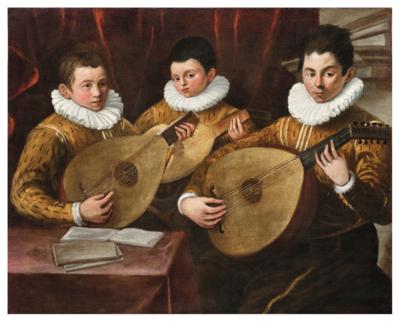Stefano Lambri, called Stefanino da Cremona or Stevenino Cremonese
(Cremona circa 1595/96–1658 Piacenza)
Three young lute players,
oil on canvas, 108.5 x 136.5 cm, framed
Provenance:
art market, France;
where acquired by the present owner
We are grateful to Marco Tanzi for suggesting the attribution of the present work and for his help in cataloguing this lot.
The present painting of three young musicians playing lutes, all elegantly dressed in ochre doublets and white ruffs, is a significant example of Emilian portraiture in the early seventeenth century. The sitters, possibly brothers, are seated around a table with sheets of music, in the background a heavy red curtain and architectural elements are visible. The intimate setting, as well as the boys’ individuation and clothing, reflect their privileged social position and suggest that this work was influenced by the pictorial language of the Duchy of Parma and Piacenza, which flourished culturally under the reign of the Farnese.
The triple portrait combines characteristics of courtly portraiture with genre elements, merging sixteenth-century Emilian tradition, apparent in the works of Gervasio Gatti or Bartolomeo Passerotti, with Flemish innovations, evident in the ‘concert paintings’ of Gerrit van Honthorst or Judith Leyster.
Working in Cremona and Piacenza, Stefano Lambri, a still rather little-studied artist, remained faithful to the artistic tradition of the late "Cinquecento". Lambri was trained in the Cremonese workshop of Giovanni Battista Trotti, called il Malosso and Andrea Mainardi, called il Chiaveghino.
The Cremonese biographer and writer Giambattista Biffi described Stefano Lambri in his eighteenth-century "Memorie per servire alla storia degli artisti cremonesi" as ‘an excellent lute and viola player, who sang falsetto with an inimitable grace, was eagerly sought after, and received everywhere with jubilation’. This would indicate that his musical skills earned him access to the sophisticated cultural circles which would have brought him important commissions. In fact, when Don Alvaro de Quiñones, Governor and Castellan of Cremona commissioned the painter Luigi Miradori, il Genovesino to work in the Castle of Santa Croce, requesting that he should be accompanied by Stefano Lambri. From 1648 until his death in 1658 Stefano Lambri lived and worked in Piacenza.
Expert: Mark MacDonnell
 Mark MacDonnell
Mark MacDonnell
+43 1 515 60 403
oldmasters@dorotheum.com
24.04.2024 - 18:00
- Dosažená cena: **
-
EUR 81.540,-
- Odhadní cena:
-
EUR 80.000,- do EUR 120.000,-
Stefano Lambri, called Stefanino da Cremona or Stevenino Cremonese
(Cremona circa 1595/96–1658 Piacenza)
Three young lute players,
oil on canvas, 108.5 x 136.5 cm, framed
Provenance:
art market, France;
where acquired by the present owner
We are grateful to Marco Tanzi for suggesting the attribution of the present work and for his help in cataloguing this lot.
The present painting of three young musicians playing lutes, all elegantly dressed in ochre doublets and white ruffs, is a significant example of Emilian portraiture in the early seventeenth century. The sitters, possibly brothers, are seated around a table with sheets of music, in the background a heavy red curtain and architectural elements are visible. The intimate setting, as well as the boys’ individuation and clothing, reflect their privileged social position and suggest that this work was influenced by the pictorial language of the Duchy of Parma and Piacenza, which flourished culturally under the reign of the Farnese.
The triple portrait combines characteristics of courtly portraiture with genre elements, merging sixteenth-century Emilian tradition, apparent in the works of Gervasio Gatti or Bartolomeo Passerotti, with Flemish innovations, evident in the ‘concert paintings’ of Gerrit van Honthorst or Judith Leyster.
Working in Cremona and Piacenza, Stefano Lambri, a still rather little-studied artist, remained faithful to the artistic tradition of the late "Cinquecento". Lambri was trained in the Cremonese workshop of Giovanni Battista Trotti, called il Malosso and Andrea Mainardi, called il Chiaveghino.
The Cremonese biographer and writer Giambattista Biffi described Stefano Lambri in his eighteenth-century "Memorie per servire alla storia degli artisti cremonesi" as ‘an excellent lute and viola player, who sang falsetto with an inimitable grace, was eagerly sought after, and received everywhere with jubilation’. This would indicate that his musical skills earned him access to the sophisticated cultural circles which would have brought him important commissions. In fact, when Don Alvaro de Quiñones, Governor and Castellan of Cremona commissioned the painter Luigi Miradori, il Genovesino to work in the Castle of Santa Croce, requesting that he should be accompanied by Stefano Lambri. From 1648 until his death in 1658 Stefano Lambri lived and worked in Piacenza.
Expert: Mark MacDonnell
 Mark MacDonnell
Mark MacDonnell
+43 1 515 60 403
oldmasters@dorotheum.com
|
Horká linka kupujících
Po-Pá: 10.00 - 17.00
old.masters@dorotheum.at +43 1 515 60 403 |
| Aukce: | Obrazy starých mistrů |
| Typ aukce: | Sálová aukce s Live bidding |
| Datum: | 24.04.2024 - 18:00 |
| Místo konání aukce: | Wien | Palais Dorotheum |
| Prohlídka: | 13.04. - 24.04.2024 |
** Kupní cena vč. poplatku kupujícího a DPH(Země dodání Rakousko)
Není již možné podávat příkazy ke koupi přes internet. Aukce se právě připravuje resp. byla již uskutečněna.

